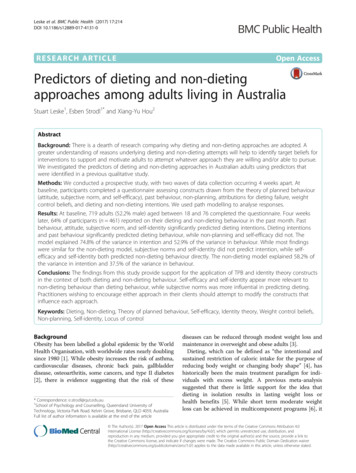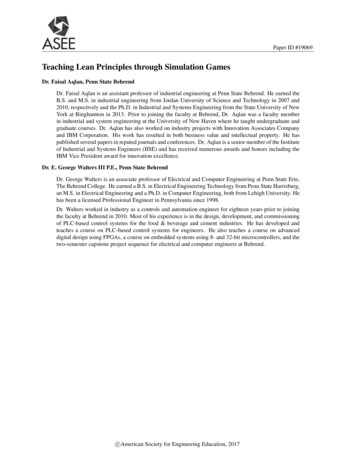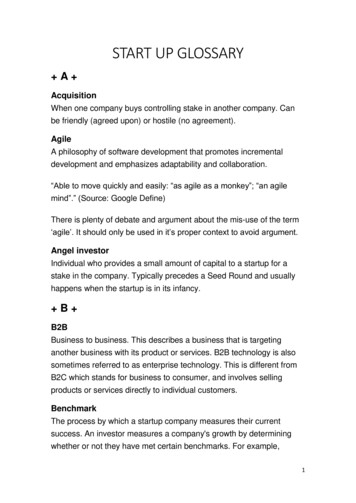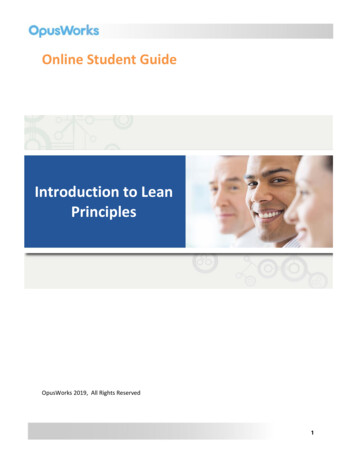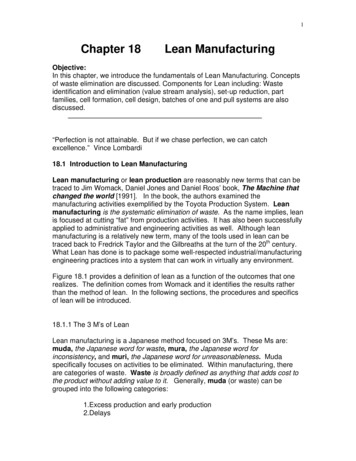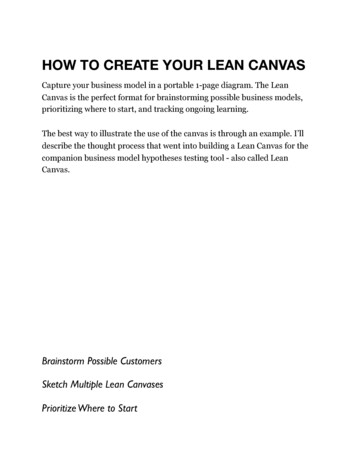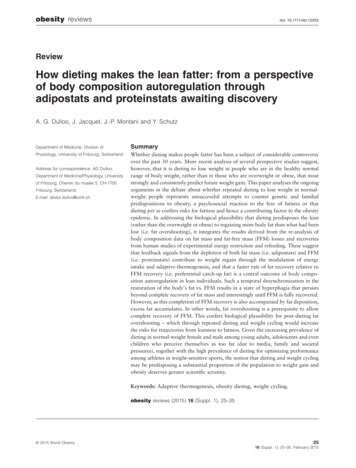
Transcription
obesity reviewsdoi: 10.1111/obr.12253ReviewHow dieting makes the lean fatter: from a perspectiveof body composition autoregulation throughadipostats and proteinstats awaiting discoveryA. G. Dulloo, J. Jacquet, J.-P. Montani and Y. SchutzDepartment of Medicine, Division ofSummaryPhysiology, University of Fribourg, SwitzerlandWhether dieting makes people fatter has been a subject of considerable controversyover the past 30 years. More recent analysis of several prospective studies suggest,however, that it is dieting to lose weight in people who are in the healthy normalrange of body weight, rather than in those who are overweight or obese, that moststrongly and consistently predict future weight gain. This paper analyses the ongoingarguments in the debate about whether repeated dieting to lose weight in normalweight people represents unsuccessful attempts to counter genetic and familialpredispositions to obesity, a psychosocial reaction to the fear of fatness or thatdieting per se confers risks for fatness and hence a contributing factor to the obesityepidemic. In addressing the biological plausibility that dieting predisposes the lean(rather than the overweight or obese) to regaining more body fat than what had beenlost (i.e. fat overshooting), it integrates the results derived from the re-analysis ofbody composition data on fat mass and fat-free mass (FFM) losses and recoveriesfrom human studies of experimental energy restriction and refeeding. These suggestthat feedback signals from the depletion of both fat mass (i.e. adipostats) and FFM(i.e. proteinstats) contribute to weight regain through the modulation of energyintake and adaptive thermogenesis, and that a faster rate of fat recovery relative toFFM recovery (i.e. preferential catch-up fat) is a central outcome of body composition autoregulation in lean individuals. Such a temporal desynchronization in therestoration of the body’s fat vs. FFM results in a state of hyperphagia that persistsbeyond complete recovery of fat mass and interestingly until FFM is fully recovered.However, as this completion of FFM recovery is also accompanied by fat deposition,excess fat accumulates. In other words, fat overshooting is a prerequisite to allowcomplete recovery of FFM. This confers biological plausibility for post-dieting fatovershooting – which through repeated dieting and weight cycling would increasethe risks for trajectories from leanness to fatness. Given the increasing prevalence ofdieting in normal-weight female and male among young adults, adolescents and evenchildren who perceive themselves as too fat (due to media, family and societalpressures), together with the high prevalence of dieting for optimizing performanceamong athletes in weight-sensitive sports, the notion that dieting and weight cyclingmay be predisposing a substantial proportion of the population to weight gain andobesity deserves greater scientific scrutiny.Address for correspondence: AG Dulloo,Department of Medicine/Physiology, Universityof Fribourg, Chemin du musée 5, CH-1700Fribourg, Switzerland.E-mail: abdul.dulloo@unifr.chKeywords: Adaptive thermogenesis, obesity dieting, weight cycling.obesity reviews (2015) 16 (Suppl. 1), 25–35 2015 World Obesity2516 (Suppl. 1), 25–35, February 2015
26 Dieting, weight cycling and predisposition to obesity A. G. Dulloo et al.IntroductionThe prevalence of obesity is well known to increase rapidly,often to reach epidemic proportions, in communities andcountries emerging into affluence. These transitions occurthrough complex interactions between genetics andchanges in an environment that favour food marketingpractices that provide easy access to palatable energy-densefoods all year round and where physical activity demandsare low. In addition to these traditional ‘Big Two’obesogenic factors, several non-traditional (non-caloric)predictors of obesity have been identified and include shortsleep duration, low dietary calcium intake, microbiotacomposition, epigenetics and developmental programming,endocrine disruptors or other pollutants (1–3). The findingsthat the risk of overweight/obesity could be higher for thecombination of some of these non-traditional (non-caloric)risk factors than for the combination of high dietary fatintake and low physical activity (3) emphasizes the importance of looking beyond strategies to counter the ‘Big Two’factors as cornerstones of obesity prevention and treatment. Paradoxically, the use of dieting for weight control –particularly among those who are in a healthy normalrange of body weight – has also emerged as a robust predictor of future weight gain and obesity, thereby raisingquestions about cause–effect relationships between dietingand fatness.This paper first reviews the evidence linking dieting tofuture weight gain and discusses the bilateral relationshipsbetween dieting and predisposition to fatness. It thenprovides, from a perspective of body compositionautoregulation, a mechanistic explanation as to howdieting and weight cycling may confer a greater predisposition to the lean (than to the overweight or obese) forexcess weight regain and fat overshooting, thereby triggering increased risks for trajectories from leanness to fatness.Prospective studies linking dieting to futureweight gainSince the early 1990s, more than 15 prospective studies(4–19), conducted over periods ranging from 1 to 15 years,have suggested that dieting to lose weight is associated withfuture weight gain and obesity, even after adjustmentfor potential confounding factors such as baseline bodymass index (BMI), age and a number of lifestyle andbehavioural characteristics. Some of these longitudinalstudies showing that dieting predicts future weight gainhave been conducted in young and middle-aged adults(4–6,8,10,11,13,15), others in adolescents as they progressinto young adulthood (14,16–18), and some in childrenprogressing into adolescence (12,19). For example, in thestudy of Field et al. (12), dieting predicted weight gain inboth pre-adolescent and adolescent boys and girls even after16 (Suppl. 1), 25–35, February 2015obesity reviewsadjustment for pubertal development, dietary intake, physical activity and BMI in the previous year, whereas in arecent study by Balantekin et al. (19), girls who reportedearly dieting (prior to age 11) with parental encouragementhad greater increases in BMI percentile from 9 to 15 yearscompared with girls whose mothers or fathers did notencourage dieting. Particularly informative are the 3-yearfollow-up studies of Stice et al. (7) showing that adolescentswith baseline dieting had three times the risk of onset ofobesity than the non-dieters, and the 10-year longitudinalstudy of Neumark-Sztainer et al. (17) showing that femaleadolescent dieters increased their BMI by 4.6 units as compared with 2.3 units in non-dieters even after adjusting forsocio-demographic characteristics and baseline BMI. Ofparticular interest is the 6- to 15-year follow-up studyreported by Korkelia et al. (8) in which the risk of majorweight gain ( 10 kg) was found to be twofold greater ininitially normal-weight subjects who were attempting tolose weight than in non-dieters. By contrast, in initiallyoverweight men and women of this same cohort (8), thehistory of weight loss attempts was not found to be consistently associated with increased risk of major weight gain.Such differential findings based upon BMI status thereforesuggest that the long-term impact of dieting on predisposition to future weight gain may be greater in the lean than inthose who are overweight or obese. Strong support for thiscontention that dieting to lose weight among the lean is arobust predictor of future weight gain can also be derivedfrom the more recent analysis by Pietiläinen et al. (18) of alarge population-based cohort of mostly normal-weightadolescents with a follow-up from adolescence to youngadulthood – which suggests a dose-dependent associationbetween the number of lifetime intentional weight losses(i.e. the frequency of weight cycling), gain in BMI and riskof overweight. Compared with subjects with no intentionalweight loss, a single episode of weight loss increased the riskof becoming overweight by three times in women and twotimes in men by age 25, and in addition, women whoreported two or more weight loss episodes had five timesgreater risk of becoming overweight at age 25. Furtheranalysis of these data (18) revealed that the rate of weightgain also differed according to three baseline BMI categories (low, intermediate and high) particularly in male, withthose in the lowest baseline BMI category gaining moreweight than those in the intermediate or high baseline BMIcategory – thereby reinforcing the contention that dietingand weight cycling most strongly predicted future weightgain in those who are the leanness.Dieting and propensity to fatness:a bidirectional relationshipWhether dieting is a causative factor for subsequent weightgain and contributes to the current obesity epidemic has 2015 World Obesity
obesity reviewsDieting, weight cycling and predisposition to obesity A. G. Dulloo et al.been a subject of considerable debate (20–22). Some haveproposed that dieting per se may actually induce weightgain subsequently (12,16–18,22). Indeed, preoccupationswith food and food obsession have often been describedlong after episodes of food deprivation or dietary restraint(23), and the central tenet of proponents for a causativeimpact of dieting on future weight gain and obesity centresupon the notion that dieting, and in particular unhealthydieting (e.g. use of diuretics, diet pills or laxatives, vomiting), predisposes to eating disorders, disinhibition andbinge eating. Others (20,21), however, argue that it is notthat dieting makes people fatter, but that the fear of becoming fat makes lean people more likely to go on a diet.According to Lowe and Levine (24), normal-weight individuals who are gaining weight are more likely to attemptto lose weight by dieting than those who are not gainingweight. However, because the weight lost on a diet isusually regained, those who are susceptible to gain weightare likely to go on weight loss diets repeatedly and hencebecome weight cyclers. In other words, individuals predisposed to obesity are more likely to engage in unsuccessfuldieting practices in order to control their pronenesstowards weight gain (24,25) – which is known to bestrongly determined by genetic and other environmentalinfluences (e.g. family, societal, learned behaviour).Genetic and familial effectsThe importance of genetic and familial impact on dietingbehaviour is indeed strongly supported by the data fromthe Finnish Twin cohort study by Korkeila et al. (8)showing that dieting aggregated in families, and henceunderscoring a familial predisposition to gain weight. Subsequent twin studies by Keski-Rahkonen et al. (26) havedemonstrated that, like proneness for obesity, episodes ofintentional weight loss has substantial genetic components,thereby underlining the possibility that individuals who aregenetically most susceptible to obesity end up dieting themost and subsequently gain the most weight. Furthermore,among a large group of female twins, Enriquez et al. (27)reported that a younger age at dieting onset is associatedwith increased BMI, dieting behaviours and episodes ofweight cycling. While the within-pair analyses showed thatgenetic and familial factors likely influence the relationshipbetween age at dieting onset and both BMI and dietingbehaviours, weight cycling episodes were associated withan earlier age at dieting onset independently of genetic andfamily factors. However, because of the cross-sectionalnature of the analysis, the question remains whether or notdieting per se is a contributing factor to excess weight gain.Beyond genetics and family factorsTo directly address this issue of whether weight gain associated with dieting is more strongly related to genetic sus 2015 World Obesity27ceptibility to weight gain than to the weight loss episodesper se, Pietiläinen et al. (18) investigated the associationbetween dieting and weight gain in more than 4,000 individual twins whose weight and height were obtained fromlongitudinal surveys at 16, 17, 18 and 25 years, and examined in relation to the number of lifetime intentional weightloss episodes of 5 kg at 25 years. The results showed thatin monozygotic twin pairs discordant for intentionalweight loss, co-twins with at least one weight loss episodewere 0.4 BMI unit heavier than their non-dieting co-twinsat 25 years of age, despite no differences in baseline BMIlevels. Similarly in dizygotic twin pairs, co-twins withintentional weight losses gained more weight ( 2.2 BMIdifference) than non-dieting co-twins at 25 years of age.Taken together, these findings (18) confirm previous studiesthat dieters may be more prone to future weight gain andthat dieters have a genetic propensity for obesity, and alsoprovide strong evidence that, in an essentially normalweight cohort, dieting per se may promote subsequentweight gain independently of genetic and familial factors. Arole for dieting and weight cycling per se in predispositionto future weight gain, beyond genetic and family factors, isalso supported by earlier findings in a national cohort ofelite male athletes who had represented Finland in international sports competition between 1920 and 1965. Thosewho performed power sports (e.g. boxing, weight lifting,wrestling) – where weight cycling is common – showedgreater gain in BMI from age 20 to 60 years over thanathletes engaged in sports without weight cycling (28).How then does dieting and weight cycling per se promotefuture weight gain? In addressing this question, it should bepointed out that the transition from weight cycling tofuture weight gain and obesity can be envisaged to occurwith or without weight and fat overshooting, the latterbeing defined as the phenomenon occurring in response toan episode of weight loss and weight regain whereby theamount of weight and fat regained are greater than whathad been lost. It is our contention here that in normalweight individuals, the occurrence of weight and fat overshooting after each cycle constitutes an important featureof the transition from weight cycling of large amplitudes tofuture weight gain and obesity. What evidence is therethat dieting in normal-weight individuals may lead to fatovershooting?Post-starvation fat overshootingSupport for this contention that dieting per se may lead toovershoot in body weight and fat can, in fact, be derivedfrom classic studies of food deprivation and refeeding innormal-weight individuals showing that more weight andfat are recovered than are lost, and in whom hyperphagiapersisted well after body weight (and fat) were fullyrecovered (Fig. 1). These phenomena of post-starvation16 (Suppl. 1), 25–35, February 2015
28 Dieting, weight cycling and predisposition to obesity A. G. Dulloo et al.obesity reviewsFigure 1 Fat overshooting after one cycle of weight loss and weight regain in normal-weight humans. The data obtained from different studiesrepresent post-starvation weight and fat overshooting (kg), as well as hyperphagic overcompensation in normal-weight men during studies ofrecovery from experimental and semi-experimental food deprivation. The black arrow pointing upwards ( ) indicates that energy intake wasmeasured in the study, and that hyperphagia was found to persist for some time after weight or fat had been completely recovered. This figure isdrawn from the tabulated data published previously (30); see text for details.hyperphagic overcompensation and weight overshoot(29,30) were first documented by Benedict (31,32) instudies of experimental total fasting or partial starvation.They were subsequently observed at the end of World WarII during follow-up studies of food rationing in Switzerlandby Fleisch (33,34), as well as in male volunteers subjectedto experimental semi-starvation and refeeding in the Minnesota Experiment conducted by Keys et al. (35). In thelatter classic study, 32 healthy volunteers completed thestudy that comprised 12 weeks of control baseline period,24 weeks of semi-starvation ( 25% weight loss) and 12weeks of restricted refeeding. Among 12 of them whoremained in the laboratory during the first 8 weeks of adlibitum refeeding, food intake increased markedly abovethe pre-starvation level. This hyperphagic response persisted for several weeks after body weight had been fullyrecovered and contributed to weight overshooting mostlyas fat.In more recent years, similar weight and fat overshooting, as well as hyperphagic overcompensation, have alsobeen reported in young men recovering from much moremodest weight loss than in the Minnesota Experiment,namely at the U.S. Army Ranger School where about 12%of weight loss was observed following 8–9 weeks of training in a multi-stressor environment that includes energydeficit (36–38) (Fig. 1). Nindl et al. (36) reported that atweek 5 in the post-training recovery phase, body weighthad overshot by 5 kg, reflected primarily in large gains infat mass, and that all the 10 subjects in that study hadhigher fat mass than before weight lost. Similarly, inanother 8 weeks of U.S. Army Ranger training course thatconsisted of four repeated cycles of restricted energy intakeand refeeding, Friedl et al. (38) showed that more weightwas regained than was lost after 5 weeks of recovery following training cessation, with substantial fat overshooting16 (Suppl. 1), 25–35, February 2015( 4 kg on average) representing an absolute increase of40% in body fat compared with pre-training levels. Fromthe data obtained in a parallel group of subjects (38), theyshowed that hyperphagia peaked at 4 weeks post-training,thereby suggesting that hyperphagia was likely persistingover the last week of refeeding, during which body fat hadalready exceeded baseline levels.Desynchronization in recovery of fat mass andfat-free massIt should be noted that in some of the above-mentionedstudies (Fig. 1) where body composition was assessed, theamount of fat overshot was greater than the amount ofweight overshot (35,38). This discrepancy in fat vs. weightovershooting can be explained by the fact that fat-free mass(FFM) was still not fully recovered, i.e. below prestarvation level, at the end of the study. Indeed, a strikingobservation from the Minnesota Experiment (Fig. 2) is thatit showed that when their body fat had been completelyrecovered (i.e. 100% control values), the FFM was not yetfully recovered and the hyperphagia, which was still verymuch evident, only disappeared when FFM was fully recovered (35).These observations about hyperphagic overcompensation and its relationship with the pattern of body composition recovery and fat overshooting raise fundamentalquestions about how control systems operate tore-establish fat mass and FFM during weight recovery,namely: What is the relative importance of fat vs. FFM depletion as determinants of post-starvation hyperphagia? What drives the faster rate of fat mass recovery relativeto FFM recovery? Since the latter preferential catch-up fat 2015 World Obesity
obesity reviewsDieting, weight cycling and predisposition to obesity A. G. Dulloo et al.29Figure 2 Dynamics of body compositionchanges in men participating in all phases ofthe Minnesota Experiment. The data areplotted to show the pattern of changes inenergy intake, body fat and fat-free mass(FFM) during semi-starvation and refeeding inthe 12 men who completed all phases of theMinnesota Experiment (including the adlibitum phase of refeeding). All values areexpressed as percentages of correspondingvalues during the control (pre-starvation)period. C12: end of 12 weeks of controlperiod; S12 and S24: end of 12 weeks and24 weeks of semi-starvation, respectively;R12 and R20: end of 12 weeks of restrictedrefeeding and 8 weeks of ad libitumrefeeding, respectively. The double-headedarrow indicates that at the time point whenbody fat had been fully recovered (i.e. 100%of control period value), FFM recovery is stillfar from complete, with hyperphagiapersisting until completion of FFM recovery.Adapted from Dulloo et al. (42).is evident even in the absence of hyperphagia (as observedin the period of restricted refeeding, S24-R12) (Fig. 2),could it be explained by an adaptive reduction in energyexpenditure (i.e. adaptive thermogenesis) that occursduring weight loss and which persists during weight recovery? What then is the relative importance of fat mass andFFM depletion as determinants of such adaptive suppression of thermogenesis during weight regain? What are the determinants of the large inter-individualvariability in partitioning of energy into FFM and fatmass during weight recovery, and in the extent of fatovershooting?These questions were previously addressed by revisiting theMinnesota Experiment and applying more elaborate statistical and analytical tools in a re-analysis of the data on thedynamic changes in body composition, energy intake andbasal metabolic rate in response to the 24 weeks of semistarvation, 12 weeks of restricted refeeding and subsequent8 weeks of ad libitum refeeding. The methodologicalapproaches and results of this reanalysis have beenreported and discussed in detail elsewhere (39–44), and themain results are summarized below.Control systems in autoregulation of bodycomposition driving fat overshootingThe main findings from our re-analysis of the data from theMinnesota Experiment, which provides insights into thedeterminants of control systems that operate through 2015 World Obesitythe control of body energy partitioning, adaptivethermogenesis and hunger/appetite during weight recovery,have been incorporated into a conceptual model ofautoregulation of body weight and body composition, andare depicted in Fig. 3a.1. The control of energy partitioning between lean andfat compartments confers to the individual’s ‘basal’ orintrinsic energy partitioning characteristic (Pc). The demonstrations (39,43) that the initial adiposity (i.e. initialpercentage fat) explains most of the inter-individual variability in Pc, and that the Pc of the individual during weightloss is conserved during weight recovery (39), suggest thatthe initial body composition expressed as percentage bodyfat (which reflects the ratio of fat to FFM) provides theindividual with a ‘memory of partitioning’, which dictatesan autoregulatory control system that underlies partitioning between protein and fat during weight loss and subsequent weight recovery.2. Thermogenesis, which is suppressed during weightloss, was found to remain suppressed during weight recovery as a function of fat depletion, but unrelated to FFMdepletion (40). This led to the concept for the existence ofa ‘fat-stores memory’, which governs an adaptive suppression of thermogenesis as a function of the replenishment ofthe fat stores (referred to as adipose-specific control ofadaptive thermogenesis). Its functional importance is toaccelerate specifically fat replenishment, thereby contributing to the disproportionate rate of body fat relative to leantissue recovery.16 (Suppl. 1), 25–35, February 2015
30 Dieting, weight cycling and predisposition to obesity A. G. Dulloo et al.obesity reviewsFigure 3 (a) Conceptual model for autoregulation of body composition during weight recovery depicting the various control systems involved,namely (i) the control of energy partitioning between fat-free mass (FFM) and fat compartments, which determines the partitioning characteristic (Pc)of the individual as a function of initial percentage body fat (or fat : FFM ratio); (ii) the adipose-specific control of thermogenesis, which specificallyaccelerates fat recovery; (iii) the ‘non-specific’ control of thermogenesis which functions as an attenuator of energy imbalance and is dictated by thefood energy flux rather than by fat depletion and (iv) hunger-appetite drive leads to hyperphagia, the magnitude of which is determined by the extentto which body fat and FFM are depleted. Adapted from Dulloo & Jacquet (43). (b) Schematic diagram showing dynamics of body compositionchanges as fat mass and FFM during one cycle of weight loss and weight regain in lean humans. The lines ‘A’ and ‘B’ represent the fullysynchronized recovery of FFM and fat mass, respectively, as determined by control of energy partitioning and the partitioning characteristic (Pc) ofthe individual (see panel (a) above), and with both FFM and fat mass theoretically reaching complete recovery simultaneously at time point ‘x’. Theline ‘C’ represents the observed value with excess fat recovery, i.e. beyond that determined by the control of partitioning and Pc of the individual;this preferential catch-up fat being driven by an adaptive suppression of thermogenesis through the adipose-specific control of thermogenesis (seepanel (a) above). The consequence of this catch-up fat phenomenon is that the recovery of fat and FFM are now desynchronized, with body fatbeing completely recovered before that of FFM, i.e. at the time point ‘y’ when fat mass is fully recovered, FFM is still far from complete recovery (timepoint ‘z’). In order to complete the recovery of FFM, hyperphagia persists due to the continued operation of proteinstatic signals linking the deficit inFFM to food intake, i.e. between ΔFFM and hunger (as depicted in panel (a) above). As a consequence of the continued operation of the control ofenergy partitioning to complete FFM recovery, fat also continues to be deposited above baseline levels (line ‘D’), resulting in the phenomenon of fat(and weight) overshooting.16 (Suppl. 1), 25–35, February 2015 2015 World Obesity
obesity reviewsDieting, weight cycling and predisposition to obesity A. G. Dulloo et al.3. The above-mentioned adipose-specific control ofadaptive thermogenesis, which specifically accelerates fatrecovery, is distinct from the ‘non-specific’ control ofthermogenesis which functions as an attenuator of energyimbalance and is dictated by the food energy flux ratherthan by fat depletion per se; it is under the influence ofleptin/insulin–sympathetic–thyroid neurohormonal axis(41).4. Hunger-appetite drive leads to hyperphagia, the magnitude of which was shown to be determined by the extentto which body fat and FFM are depleted, with the degree offat depletion being the stronger determinant (42). Thishyperphagic response therefore seems to be dictated notonly by a ‘memory’ of the initial fat stores but also by a‘memory’ of the initial FFM compartment. The functionalimportance of this increase in the hunger-appetite sensation, with consequential hyperphagia, is to accelerate therestoration of both lean and fat compartments, as definedby the Pc of the individual.Thus, besides the control of partitioning per se, othercontrol systems operating via the control of food intakeand thermogenesis with feedback loops from the leanand/or fat tissue compartments are conceptualized to bedictated by ‘memories’ of the FFM and/or fat compartment. These are viewed as attenuators of energy imbalance and/or accelerators of tissue recovery that aresuperimposed over a more ‘basal’ control of energy partitioning. As can be observed in Fig. 3a, there is a sharpcontrast between the determinants of the two acceleratorsof tissue recovery: whereas the control system operatingthrough increased hunger-appetite is dictated by thedegree of depletion of both fat and FFM, that operatingthrough the adipose-specific suppression of thermogenesisis dictated specifically by the degree of depletion of thebody’s fat mass only (and not by FFM depletion). As previously pointed out (30,39), this differential relationshipof hyperphagia and suppressed thermogenesis with regardto the two main energy-containing compartments underscores an asymmetry in the way FFM and fat mass arerecovered, with fat being recovered at a faster rate thanFFM – a phenomenon that we have referred to as preferential catch-up fat (45). Thus, the greater the severity ofweight loss (and the degree of fat and FFM depletion), themore the suppression of thermogenesis that enhances specifically fat recovery (and not FFM recovery) and hencethe greater the disparity in the rate of fat vs. FFM recovery (Fig. 3b). As we previously emphasized (30), thiswould provide an explanation for the fact that when fatrecovery in the Minnesota men or Army Rangers reached100% of pre-starvation values, the FFM recovery was stillfar from complete. Since depleted FFM can also drivehyperphagia (42), a consequence of the disparity betweencomplete fat recovery and incomplete FFM recovery is 2015 World Obesity31that the hyperphagia is prolonged until FFM is also fullyrecovered. However, since the completion of FFM recovery can only be achieved through the process of energypartitioning, more body fat is also deposited, which henceunderscores the phenomenon of fat overshooting. Inother words, excess gain in fat mass (i.e. fat overshoot)appears as a prerequisite to allow complete recovery ofFFM.Inverse relationship between adiposity prior toweight loss and fat overshootingThe critical event that eventually leads to the prolongation of hyperphagia beyond the complete recovery of fatmass (and hence fat overshooting) resides in the adaptivesuppression of thermogenesis which drives fat recovery ata rate that is greater than that determined by the Pc of theindividual. As this enhanced metabolic efficiency (adiposespecific suppression of thermogenesis) that drives fatacceleration is a function of fat depletion, and the prolongation of hyperphagia beyond complete recovery of fatmass is a function of depleted FFM still to be recovered,the extent of fat overshooting would therefore dependupon the extent to which both fat mass and FFM aredepleted. This, in turn, depends upon the Pc of the individual, which is dictated primarily by the initial percentage body fat, i.e. the level of adiposity prior to weigh
genetically most susceptible to obesity end up dieting the most and subsequently gain the most weight. Furthermore, among a large group of female twins, Enriquez et al. (27) reported that a younger age at dieting onset is associated with increased
